We may receive a commission on purchases made from links.
Rock salt (sodium chloride) is commonly applied to roads in order to efficiently melt the ice that accumulates throughout winter in cold climates. Municipalities rely on it because it’s affordable and effective at getting the job done, but it also causes a lot of unintentional damage to the trees, shrubs, and flowering plants that get hit by the salt spray. And it’s not just salt trucks that do damage: You might also sprinkle some a little too close to your flowerbeds when trying to de-ice your sidewalks or garden paths. Excessive doses are considered toxic to plant life. They dry out root systems when they seep into the soil, cause salt burns on foliage and buds, and physically rub away protective layers, leaving new growth tissue exposed to the harsh elements.
If you’re a gardener or hobby landscaper living in a cold climate zone, you’re likely dreading the upcoming onslaught of rock salt applications and wondering what you can do to mitigate and minimize damage. From starting out with the right plants to best maintenance practices and creating all sorts of barriers, we’ve got all the tips you need to keep your beloved plants safe from salt damage this winter.
Start by planting salt-tolerant plants
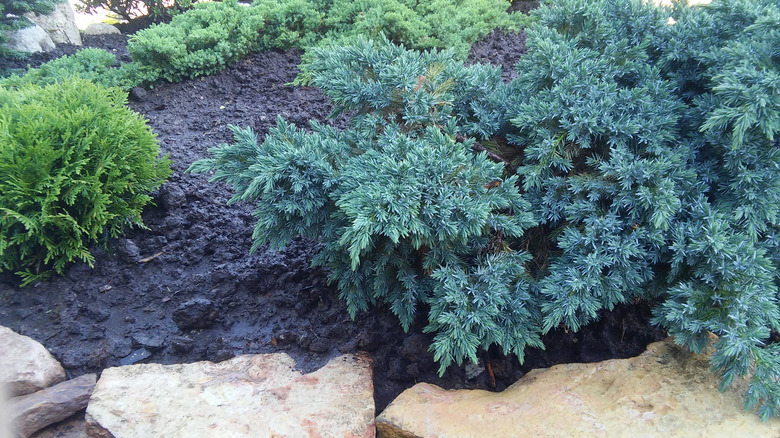
Of course, prevention is one of the most important tactics when it comes to many problems in life, so if you’re just starting out in the garden, why not set yourself up for success? Design a space that is mostly populated by salt-tolerant plants, or use them to create a border around whichever edges are most likely to be affected by road or driveway salt applications. This way when the inevitable splattering of ice melt arrives in your neighborhood via municipal trucks, you’ll know that the plants guarding your yard will be able to handle it.
A short list of options here includes winterberry holly (Ilex verticillata), bee balm (Monarda didyma), creeping juniper (Juniperus horizontalis), and eastern red cedar (Juniperus virginiana). But there are a number of environmental factors that will ultimately decide which of these will work for you, such as your soil type and the climate zone where you live. Note also that some plants are tolerant of salt spray on foliage, while others are better at dealing with salt in the soil. A few evergreens, like the juniper pictured above, can handle both. Another option is to plant everything a few feet away from sidewalks and roadways to create a buffer zone.
Shovel early and often
Step two in preventative maintenance is to get outside early and often anytime it snows. If you remove the buildup before it turns into ice, you won’t need to use salt on your sidewalks and walkways, further protecting your garden. When you live in a cold climate, this is your best tactic for keeping walkways and plant life safe. If ice forms quickly where you live, pick up an ice chipper tool at the hardware store in addition to a sturdy snow shovel. The chipper will have a long handle like a shovel but with a steel blade on the end that will allow you to break and scrape any already-formed ice; then you can shovel those pieces along with the snow.
Shoveling heavy snow will give your body quite a workout. Wear appropriate layers, stay hydrated, and only do as much as you can safely. Decide in advance where exactly you want to pile up all the snow (more on best placement below), and push the snow along the ground in that direction so you only have to toss it so far.
Use the minimum amount of salt for the least potential damage
Willowpix/Getty Images
In the event that you do turn to chemical applications, try to use the least amount possible and target your applications appropriately. Not overdoing it helps ensure the salty water runoff won’t go into your grass or nearby flower beds. Shovel and sweep away all the snow so that the de-icer is applied directly to the ice. You may want to keep a plastic cup or recycled laundry detergent bottle so you don’t apply more than you need, which is only about 12 ounces for a whole 20-foot driveway. If you think about it, that’s the same as a can of soda — any more than that, and you’re probably overdoing it.
As you spread the salt around, you want to make sure there are a few inches between the particles so they don’t form into clumps. If you notice some salt was spread on patches where there isn’t ice, take your shovel and remove them. This also ensures they won’t be kicked or blown to nearby shrubs or gardens. Once it has been applied, it’s time to head inside and warm up with a cup of cocoa.
Water the ground anytime it thaws
Jade Prevost Manuel/Shutterstock
Here’s a tactic that will help flush away the excess salt that remains even after you’ve shoveled and used the least amount of chemicals possible: Water the ground anytime it thaws. This may sound counterintuitive considering we’re talking about winter — and you surely don’t want to create more ice while you’re in the process of getting rid of what’s already accumulated — but hear us out. By turning on the hose whenever the ground is able to absorb water, you wash away the salt. Keep in mind that you can only do this with well-draining soils, and you want to make sure the temperatures will stay warm for long enough that the water is sucked into the ground and doesn’t pool at the top, where it could later turn into ice.
If you’re still not convinced about watering when it’s cold outside, understand that wet soil is better for root systems, and it’s generally advised that you water your plants and lawn the day before you’re expecting the ground to freeze. That’s because moist soil acts as warm padding, whereas dry soil offers no insulation and doesn’t protect roots from damage. In addition to leaching away the harmful salt buildup, the water will hydrate the plants and insulate them, both of which keep them free from frost damage.
Designate a discarded snow pile away from plants and trees
Stefanikolic/Getty Images
So you’re out there shoveling like a machine to get all that salt-laden slush away from your precious garden plants, only to turn around and realize you’ve covered your front lawn with it. Oops. The high levels of rock salt are just as toxic to the grass as they are to the seemingly less substantial annual and perennial flower beds. At this point, there’s not a lot you can do other than be better prepared for next time.
Something as simple as designating an area to act as home to a discard pile can do a lot to minimize salt damage to plants. Maybe there’s room on the pavement, driveway, or along the edge of a cul de sac. Maybe there’s one spot in your lawn that’s already suffering for another reason and is just going to keep being the dead spot. Wherever you pick, try to be strategic about where you place all the snow you’re shoveling so you don’t end up causing unnecessary damage elsewhere.
Wrap plants in burlap to protect them
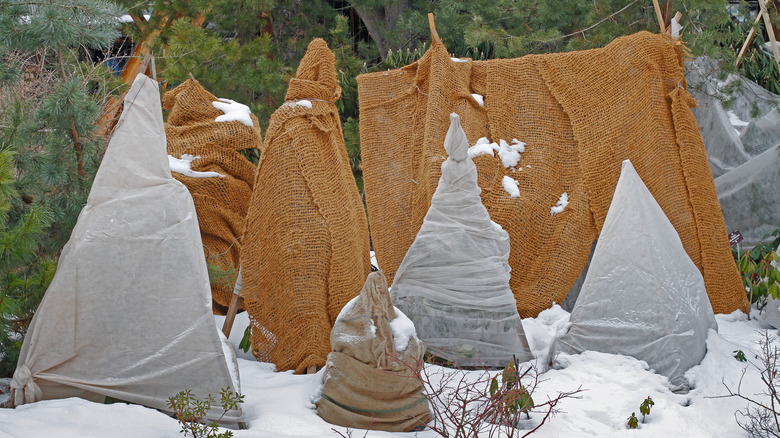
Yulyao/Getty Images
Wrapping shrubs and small trees in burlap is a common occurrence for general landscape winterizing to protect them from freezing temperatures. This will also keep them shielded from salt that sprays out of maintenance trucks and bounces up into your yard. Use large stakes to create a frame around each plant, and then wrap the frames with burlap. Twine or heavy-duty staples will keep it from blowing away or slipping. To further protect the plants, leave space between the fabric and the foliage. If the burlap were to get wet from precipitation and freeze, for instance, it could hurt whatever plants it was touching.
Remember that this is a good fix for keeping salt off foliage and tree trunks, but it will not affect salt being absorbed into the soil. Also, you don’t want to keep the burlap in place indefinitely. Rather, you can leave it there when freezing temperatures, heavy snow, and rock salt application are imminent and then peel it back when the weather warms and the trucks have passed.
Build a temporary plastic or mesh fence
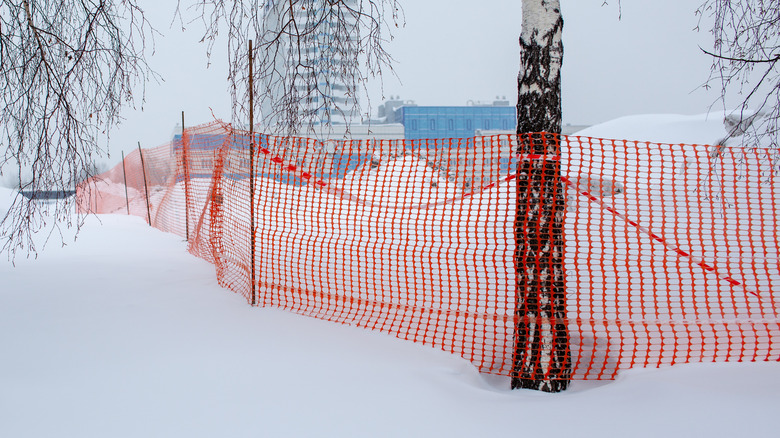
ANATOLY Foto/Shutterstock
This option may not be the most attractive but it does really help. Installing a temporary barrier to block roadside salt application from penetrating your yard can be as basic or complex as you want to make it. A roll of mesh fencing can be purchased at a home and garden center like Lowe’s or Home Depot. You’ll also find it on Amazon by searching for plastic mesh fences. And don’t worry, it’s not always fluorescent orange. There are less noticeable options like green or black.
This is the same type of material you might use to prevent wildlife from entering your garden and devouring your vegetables in the summer. In fact, you might even consider repurposing what you already have. If it’s in good condition, try relocating your fencing with the change of seasons to make sure it’s positioned to be as effective as possible throughout the year. Another thing to try is installing vinyl fence panels. They’re certainly more expensive than mesh fencing, but they would create a much sturdier barrier.
Skip the salt and go for sand, gravel, or cat litter instead
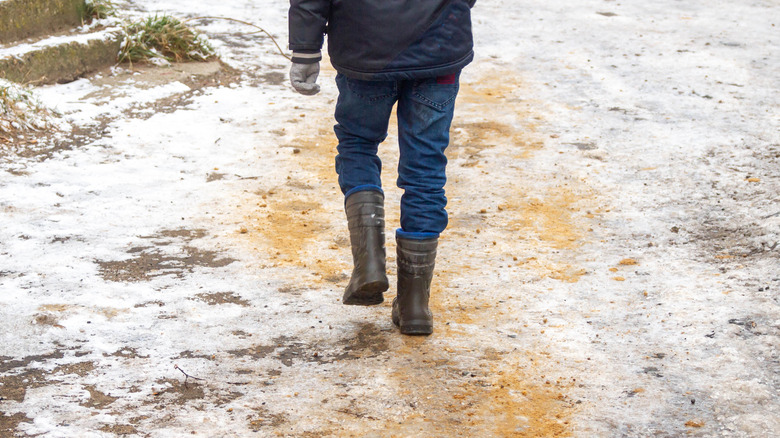
Olga Evtushkova/Getty Images
The primary benefit of switching from salt or chemical ice melt to something like coarse sand, gravel, or cat litter is that the alternatives are less corrosive because they don’t contain sodium chloride. They are applied in order to create traction and make the icy areas considerably less slippery. That said, they don’t in fact melt the ice away. If melting the ice is a top priority, but you still want to shy away from harsh chemicals, you can mix two of these compounds together — for instance, a little bit of sodium chloride-based ice melt plus a larger quantity of sand. Sawdust can also be mixed in as a filler.
Cat litter is a less reliable option, but it can be helpful, though some people complain that because it absorbs water, it turns into a slippery, sludgy mess. Other deicing agents that do not contain harmful sodium (salt) include calcium chloride or calcium magnesium acetate (CMA), which is made from limestone and acetic acid.
Don’t rely on coffee grounds
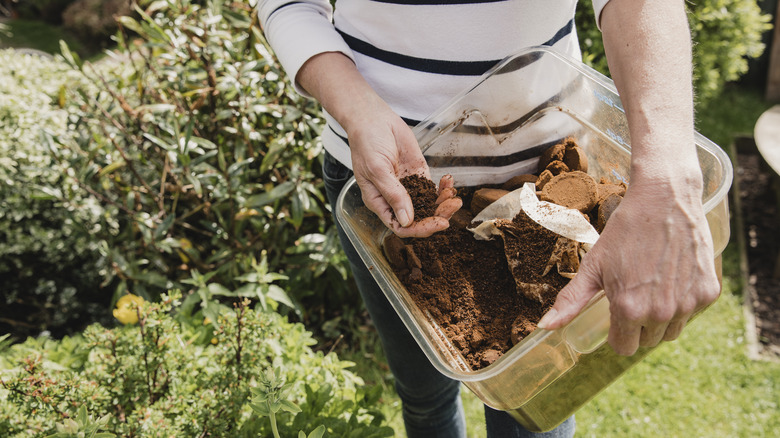
Dglimages/Getty Images
Sand, gravel, and cat litter work well in place of chemicals, but if you’re wondering whether coffee grounds can really double as an effective de-icer during winter, unfortunately, the answer is no. We’re not sure where the myth came from that they would work because there’s nothing about their chemical composition that does anything to melt ice. Similar to sand, they can be used to improve friction between shoes and ice. But even so, you would have to consume quite a lot of java in order to have enough used grounds to cover a walking path, driveway, or even just your front steps.
There are plenty of excellent applications for coffee grounds in the garden, from composting to improving soil fertility with nitrogen. Just save these applications for the spring and summer. In the winter, keep your coffee grounds inside and employ them throughout the house to deodorize shoes and clean your pots and pans.


